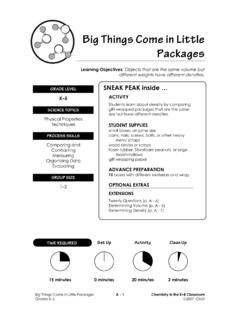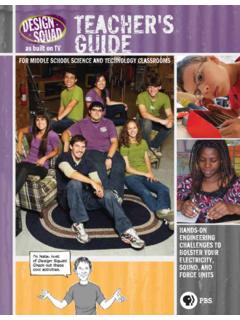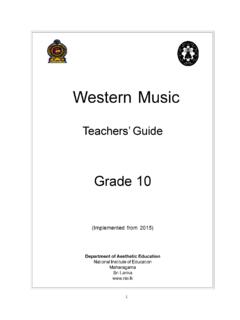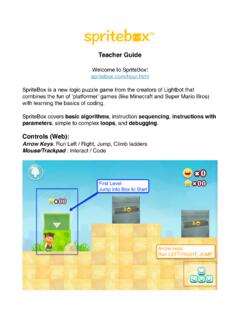Transcription of Teachers’ Guide - OMSI
1 Teachers Guide Teachers Guide 1 Design Zone 2010, OMSI Teachers Guide Table of Contents HOW TO USE THIS EXHIBITION EXHIBIT CORRELATION TO EDUCATIONAL TOPICS BY ACTIVE LEARNING FACILITATION CLASSROOM Teachers Guide 2 Design Zone 2010, OMSI How to Use This Teachers Guide These materials have been developed as a supplementary resource for educators bringing their students to the Design Zone exhibit. Included are background information, connections to standards, strategies for working with students in the exhibit, classroom activities that tie to the exhibit, and the Active Learning Log an open-ended worksheet for students to fill out while exploring the exhibit. The various materials can be used independently, combined to ensure a rich experience for classes visiting Design Zone, or adapted to meet your classroom goals.
2 Teachers Guide 3 Design Zone 2010, OMSI Exhibition Overview What does it take to create a video game, line up rhythms like the best DJs, or design a roller coaster that produces the biggest thrills? In Design Zone, students can go behind the scenes and see how video game developers, music producers, roller coaster designers, and other creative problem solvers use math to do the amazing things they do. Design Zone explores mathematical concepts like patterns, variables, scale, slope, and ratios used by artists, architects, engineers, musicians, and other innovators. Design Zone is: A nontraditional, experiential approach to math, focusing on math concepts as a tool to create and invent everything from hip-hop to skate parks. A means to promote innovation and build math literacy essential for careers in the twenty-first century by directly connecting mathematical concepts to real-life experiences.
3 A substantial professional development program for host museums, designed to leave a lasting impact on interpretive and education staff. Design Zone is organized into three highly interactive thematic areas, highlighting the relationship between mathematical thinking and the creative process in art, music, and engineering. Each thematic area draws students into compelling scenes of music production, videogame development, and extreme sports that directly and experientially relate mathematical concepts to environments and activities attractive to youth. Students can design their own experience and. They ll solve real-world challenges and discover that math isn t just a subject in school but a fundamental, creative tool that can be used to design and invent! Teachers Guide 4 Design Zone 2010, OMSI Goals Design Zone exhibits are about functions, patterns, and predicting; when one quantity changes, another changes in a predictable way.
4 The exhibit and complementary materials were developed with the following goals for student experience: Students will have enjoyable and social experiences with algebra/math. Groups of students will feel comfortable engaging in algebra/math activities together. Students will use algebraic thinking skills and engage in mathematical exploration. The exhibition s primary educational goal is for students to use algebraic thinking, a form of mathematical exploration, as they engage in creative problem solving. Like scientific inquiry, mathematical exploration is a powerful tool for understanding the world around us. Design Zone offers students an engaging and stimulating experience where they solve challenges, use creative thinking and problem-solving strategies, and consider problems from different perspectives. Students will use algebraic thinking in the exhibit by: Finding and exploring mathematical patterns and relationships between quantities.
5 Representing mathematical relationships in a variety of ways, including images, words, models, graphs, and symbols. Using mathematical relationships to describe, analyze, predict, and create. Mathematical exploration is a process similar to scientific inquiry that: Identifies variables Identifies patterns and relationships between those variables Asks questions like: o What is changing? o How is it changing? o Can I measure it? o How does a change in one variable affect another? Teachers Guide 5 Design Zone 2010, OMSI Exhibit Components Design Zone s three thematic areas and exhibit components are described in depth below. ART See It! Creative inspiration may come from anywhere, but whether it s digital design, architecture, or video games, visual designers use mathematical thinking to turn ideas into reality. In this area, students design their own 2-D and 3-D art and explore the math behind visual creativity.
6 Math concepts include: visual patterns, scale and proportional reasoning, coordinate grids, equality, rate of change, and slope. Exhibit clusters: Digital Design Domain, Architecture Studio, Video Game Design Lab Digital Design Domain Explore the math of visual patterns Drawing in Motion Coordinate grids help Web designers organize visual information, architects create scale drawings, and video game designers plot the movement of objects across a screen. In this full body iconic experience, two students become the designers as they move large sliders along number lines to manipulate a digital pen and draw on a monitor display. As they work together to create images, students will discover the math behind the concept of slope. Mirror Multiplier Many visual designs depict reflectional, rotational, or translational symmetry. In this exhibit students can explore reflectional symmetry using colorful geometric pieces and a hinged pair of mirrors. Students try to match several challenge images or create their own designs, while discovering the relationship between mirror angle and number of images.
7 Picture Calculator Students take a picture of themselves and manipulate the values of the pixels to transform their photo. They can highlight a part of the image and then use a calculator-like interface to create simple functions that transform the highlighted section of the gray scale image. Students can choose a project from a gallery and create certain visual effects, such as heightened contrast or a negative image, or come up with their own transformations in Free Draw. Teachers Guide 6 Design Zone 2010, OMSI Architecture Studio Use math to design and build in three dimensions Balancing Art Mobiles balance because of a relationship between the weights on each side of the balancing rod and their distance from the center of the fulcrum of the rod. Students discover the math behind mobiles as they create their own balancing art from colorful pieces. Build a Wall, Build a Plaza, Build a Tower Students test their abilities to continue a pattern in three dimensions as they try building a wall, a plaza, or a tower from custom printed architectural blocks.
8 Videogame Design Lab Discover the algebra designers use to model virtual worlds and create on-screen action Marble Maze Video game designers use algebra to create games with the right feel and level of challenge. Students start with a simple marble maze game controlled by a giant tilt table. The goal of the game is to navigate the maze, avoid the black holes, and roll over stars to collect points. A simple equation relates the size of the holes, the bounciness of the marble, and the number of points per star. Students can adjust the variables and design a game that gives them the highest score. Jump on It For a video game designer, creating motion in a virtual world involves knowing how variables like jump power and gravity interact. This game is similar to many classic arcade games. Students choose a character, select a scene, and adjust the jump power and gravity to find out how these variables affect their character s jump height as they land on platforms, collect stars, and try to complete all four jump challenges.
9 Hit the Target Video game designers have to model real world motion like balls flying through the air to make their games more realistic and fun. Graphs and equations help them do that. In this full-body experience, students can launch a ball in the air and attempt to hit a target while learning more about the relationship between release angle and distance traveled by adjusting the release angle of a ball and trying to hit a series of lighted targets. Teachers Guide 7 Design Zone 2010, OMSI MUSIC Hear It! Students go behind the scenes and put together music tracks at a DJ recording studio, design and play instruments that reflect the mathematical relationships between length and pitch, and create a laser light show to get their friends dancing. Math concepts include: rhythmic patterns, ratios, and proportional thinking. Exhibit clusters: DJ Recording Studio, On Stage!, Dance Party DJ Recording Studio Explore the math behind rhythm and music Sound Graph What does sound look like?
10 Students can talk, sing, or whistle into a microphone and see the sound displayed on a colorful, real-time graph of pitch over time. They are challenged to try making sounds to match specific graph shapes. Drum Machine When mixing a new song, DJs have to think about the number of beats in each music track and how they line up with each other. Students pick the sounds and the number of repeats for a two-beat track, a three-beat track, and a four-beat track and see if they can get all three tracks to end on the same beat. Music Mix Students try out their music production skills by putting together actual music samples. They choose samples, select the number of repeats for each, and try to match the total number of beats to a pre-recorded rhythm track. Turntables How does a DJ move seamlessly between two songs on the turntables? It takes math. DJs can only mix songs together if they have the same beats per minute, slowing down or speeding up songs to make the beats match.














